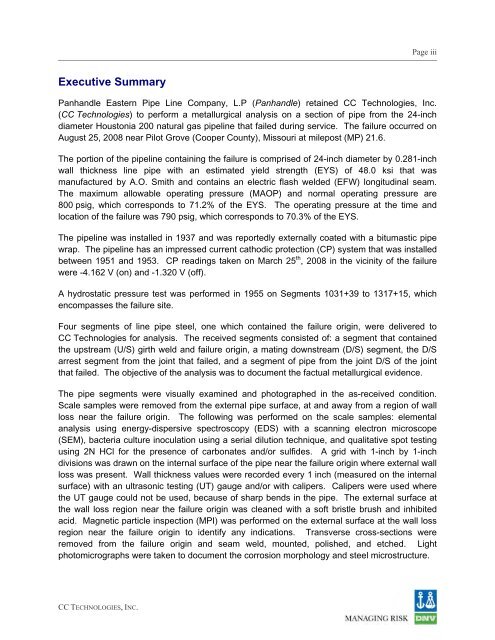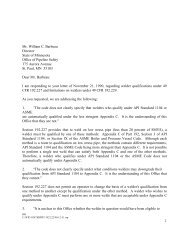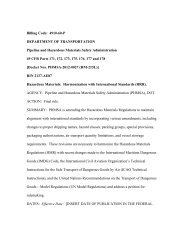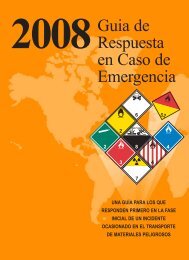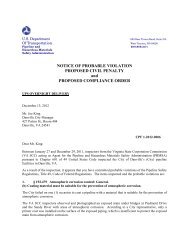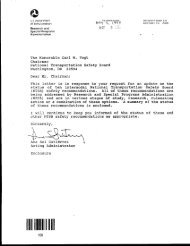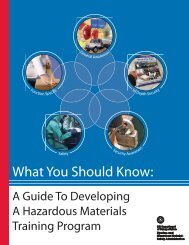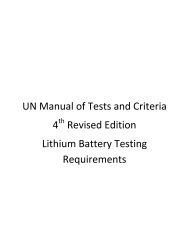Pipeline Failure Investigation Report - PHMSA - U.S. Department of ...
Pipeline Failure Investigation Report - PHMSA - U.S. Department of ...
Pipeline Failure Investigation Report - PHMSA - U.S. Department of ...
You also want an ePaper? Increase the reach of your titles
YUMPU automatically turns print PDFs into web optimized ePapers that Google loves.
Page iii<br />
Executive Summary<br />
Panhandle Eastern Pipe Line Company, L.P (Panhandle) retained CC Technologies, Inc.<br />
(CC Technologies) to perform a metallurgical analysis on a section <strong>of</strong> pipe from the 24-inch<br />
diameter Houstonia 200 natural gas pipeline that failed during service. The failure occurred on<br />
August 25, 2008 near Pilot Grove (Cooper County), Missouri at milepost (MP) 21.6.<br />
The portion <strong>of</strong> the pipeline containing the failure is comprised <strong>of</strong> 24-inch diameter by 0.281-inch<br />
wall thickness line pipe with an estimated yield strength (EYS) <strong>of</strong> 48.0 ksi that was<br />
manufactured by A.O. Smith and contains an electric flash welded (EFW) longitudinal seam.<br />
The maximum allowable operating pressure (MAOP) and normal operating pressure are<br />
800 psig, which corresponds to 71.2% <strong>of</strong> the EYS. The operating pressure at the time and<br />
location <strong>of</strong> the failure was 790 psig, which corresponds to 70.3% <strong>of</strong> the EYS.<br />
The pipeline was installed in 1937 and was reportedly externally coated with a bitumastic pipe<br />
wrap. The pipeline has an impressed current cathodic protection (CP) system that was installed<br />
between 1951 and 1953. CP readings taken on March 25 th , 2008 in the vicinity <strong>of</strong> the failure<br />
were -4.162 V (on) and -1.320 V (<strong>of</strong>f).<br />
A hydrostatic pressure test was performed in 1955 on Segments 1031+39 to 1317+15, which<br />
encompasses the failure site.<br />
Four segments <strong>of</strong> line pipe steel, one which contained the failure origin, were delivered to<br />
CC Technologies for analysis. The received segments consisted <strong>of</strong>: a segment that contained<br />
the upstream (U/S) girth weld and failure origin, a mating downstream (D/S) segment, the D/S<br />
arrest segment from the joint that failed, and a segment <strong>of</strong> pipe from the joint D/S <strong>of</strong> the joint<br />
that failed. The objective <strong>of</strong> the analysis was to document the factual metallurgical evidence.<br />
The pipe segments were visually examined and photographed in the as-received condition.<br />
Scale samples were removed from the external pipe surface, at and away from a region <strong>of</strong> wall<br />
loss near the failure origin. The following was performed on the scale samples: elemental<br />
analysis using energy-dispersive spectroscopy (EDS) with a scanning electron microscope<br />
(SEM), bacteria culture inoculation using a serial dilution technique, and qualitative spot testing<br />
using 2N HCl for the presence <strong>of</strong> carbonates and/or sulfides. A grid with 1-inch by 1-inch<br />
divisions was drawn on the internal surface <strong>of</strong> the pipe near the failure origin where external wall<br />
loss was present. Wall thickness values were recorded every 1 inch (measured on the internal<br />
surface) with an ultrasonic testing (UT) gauge and/or with calipers. Calipers were used where<br />
the UT gauge could not be used, because <strong>of</strong> sharp bends in the pipe. The external surface at<br />
the wall loss region near the failure origin was cleaned with a s<strong>of</strong>t bristle brush and inhibited<br />
acid. Magnetic particle inspection (MPI) was performed on the external surface at the wall loss<br />
region near the failure origin to identify any indications. Transverse cross-sections were<br />
removed from the failure origin and seam weld, mounted, polished, and etched. Light<br />
photomicrographs were taken to document the corrosion morphology and steel microstructure.<br />
CC TECHNOLOGIES, INC.


